Forecasting the cost performance is vital for controlling project costs and improving the project performance. The To-Complete Performance Index (TCPI) is a tool that helps project managers control the project cost.
The TCPI helps project managers find budgetary deviations before they occur. TCPI is a relatively new term and popularized by the PMBOK Guide. This excellent tool helps project managers calculate the future cost performance of the project.
Today’s blog post will discuss TCPI in detail, its formula, examples, and how to use it in project management to control costs.
What is TCPI (To-Complete Performance Index) in Project Management?
The To Complete Performance Index (TCPI) is the cost performance index for the remaining work you must meet to complete the project on a budget (BAC or EAC).
Put simply, the To Complete Performance Index estimates the future cost performance you may need to complete the project within the approved budget.
According to the PMBOK Guide, “TCPI is the calculated Cost Performance Index that is achieved on the remaining work to meet the specified management goal, such as the BAC or the EAC.”
TCPI shows the variations in the cost performance in the future course of action; you can see how much adjustment you need to stay inside the budget.
TCPI = (Cost Required to Complete the Residual Work) / (Remaining Budget)
The ratio can be one, less than, or more than one.
The interpretation of this ratio is as follows:
- If TCPI = 1, you can complete the project with the existing budget.
- If TCPI < 1, you will complete the project under budget.
- If TCPI > 1, you will exceed the existing budget.
TCPI Formulas
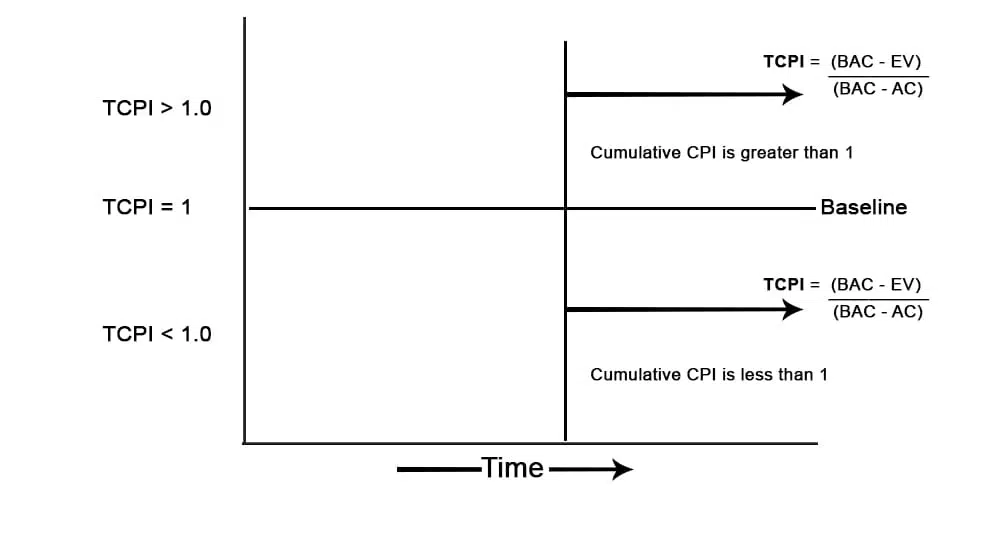
To understand the TCPI formula, let us know the parameters used in the formulas:
EV = Earned Value
AC = Actual Cost
BAC = Budget at Completion
EAC = Estimate at Completion
You can calculate the TCPI by dividing the remaining work by the remaining funds.
TCPI = (Remaining Work) / (Remaining Funds)
You can calculate the remaining work by subtracting the Earned Value from the total budget.
Remaining Work = Total budget – Earned Value
= (BAC – EV).
You can find the remaining funds in two cases: when you are under budget and when you are over budget.
The To Complete Performance Index formula will be different in both cases.
Let’s discuss these two cases.
Case-I: You Are Under Budget
Here, you will calculate the remaining funds by subtracting the “actual cost incurred to date” from the “initial budget.”
The remaining funds = Budget at Completion – Actual Cost
= BAC – AC
The TCPI formula will be
TCPI = (BAC – EV) / (BAC – AC)
Case-II: You Are Over Budget
Here, you will calculate the remaining funds by subtracting the actual cost incurred to date from the Estimate at Completion.
The remaining funds = Estimate at Completion – Actual Cost
= EAC – AC
Here, the TCPI will show you the required cost performance to complete the project with the newly calculated budget.
TCPI= (BAC – EV) / (EAC – AC)
Example of TCPI Calculation (Using BAC)
You are working on a project to be completed in 24 months. The BAC of the project is 200,000 USD. 12 months have passed, you have spent 110,000 USD, and 60% of the work has been completed.
Find the To Complete Performance Index (TCPI) for this project.
Given in the question:
Budget at Completion (BAC) = 200,000 USD
Actual Cost (AC) =110,000 USD
Planned Value (PV) = 50% of 200,000
= 100,000 USD
Earned Value (EV) = 60% of 200,000
= 120,000 USD
Cost Performance Index (CPI) = EV / AC
= 120,000 / 110,000
= 1.1
Since the Cost Performance Index is 1.1, which is greater than one, you are under budget. Therefore, in this case, you will use the TCPI formula based on the BAC.
TCPI = (BAC – EV) / (BAC – AC)
= (200,000 – 120,000) / (200,000 – 110,000)
= 80,000 / 90,000
= 0.89
This means that you can continue with a Cost Performance Index of 0.89 to complete the project.
Example of TCPI Calculation (Using EAC)
You have a project to be completed in 12 months. The project budget is 100,000 USD. 6 months have passed, and you have spent 60,000 USD, but on closer examination, you find that only 40% of the work has been completed so far.
Find the To Complete Performance Index (TCPI) for this project.
Given in the question:
Budget at Completion (BAC) = 100,000 USD
Actual Cost (AC) = 60,000 USD
Planned Value (PV) = 50% of 100,000
= 50,000 USD
Earned Value (EV) = 40% of 100,000
= 40,000 USD
Cost Performance Index (CPI) = EV / AC
= 40,000 /60,000
= 0.67
Hence, the Cost Performance Index (CPI) = 0.67
Since the Cost Performance Index is less than one, you are over budget. Now, you will calculate the new Estimate at Completion and use a formula based on the EAC.
Estimate at Completion (EAC) = BAC / CPI
= 100,000 / 0.67
= 149,253.73 USD
Hence, the Estimate at Completion (EAC) = 149,253.73 USD
Now, TCPI = (BAC – EV) / (EAC – AC)
= (100,000 – 40,000) / (149,253.73 – 60,000)
=60,000 / 89,253.73
=0.67
TCPI = 0.67
This means that you can continue with a Cost Performance Index of 0.67 to complete the project.
If you have calculated the Estimate at Completion using the Earned Value Management formula (EAC = BAC / CPI), the TCPI will be equal to the CPI when you calculate the TCPI the first time. This is because you have assumed that the future cost performance of the project will be the same as the past while calculating the Estimate at Completion (EAC).
CPI Vs TCPI
CPI is the cost performance index for the project, and TCPI also provides the project cost performance. You might wonder what the difference between the two concepts is.
CPI provides the past and current cost performance, while TCPI provides the future cost performance of the project.
The formula to calculate CPI is as follows.
CPI = EV/AC
The Formulas to Calculate TCPI are as follows:
TCPI = (BAC – EV) / (BAC – AC)
And,
TCPI = (BAC – EV) / (EAC – AC)
CPI and TCPI complement each other and are part of the performance report. They show where the project is and what needs to be done to complete it and achieve its objectives without deviating from the project baselines.
TCPI Vs ETC Vs EAC
TCPI provided the required efficiency to meet project goals by calculating the ratio of remaining work to the remaining budget.
ETC (Estimate to Complete) estimates the additional cost required to finish the remaining project work by subtracting actual costs from the total estimated cost.
EAC (Estimate at Completion) provides a projection of the total project cost based on current performance and estimates for remaining work.
The following table shows the key difference between these three forecasting terms:
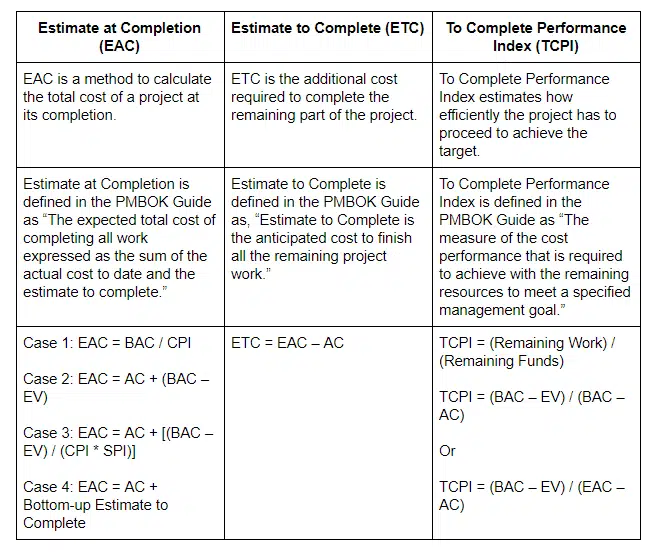
A Real-World Example of TCPI
Suppose you have a project to paint 10,000 square feet in 10 days. This means you have to paint 1,000 square feet per day.
When you review your progress halfway through, you find that only 3,000 square feet have been painted.
You have five days left and 7,000 square feet yet to be painted. You calculate that you will have to paint 1,400 square feet daily to complete the task within ten days. This must be your future performance to complete the task on time. This future performance is the To Complete Performance Index (TCPI).
The Cost Performance Index (CPI) is your past performance, and the TCPI is the future performance you must meet to complete the project within the approved budget.
You can also calculate what will happen if you paint 7,000 square feet to this date. This means you now have to paint 3,000 square feet in 5 days. Here, you can paint 600 square feet daily to complete the task, which is a more comfortable goal.
Before concluding this post, let’s revisit a few key points:
- CPI is the past cost performance of the project, and TCPI is the future cost performance of the project.
- If you are under budget, you will calculate the TCPI based on the BAC.
- You will calculate the TCPI based on the EAC if you are over budget.
- If the To Complete Performance Index is less than one, you are in a comfortable position.
- You have to perform better than the past cost performance if the To Complete Performance Index exceeds one. You can continue with the same cost performance if the To Complete Performance Index equals one.
Summary
The To-Complete Performance Index is a forecasting tool that helps you determine the future cost efficiency of the project. It tells you how effectively you should use your resources to complete the project on budget. It is good if the TCPI is less than one, while the reverse is true with performance indexes: if the indexes are greater than one, it is good for the project.
The TCPI concept is important from a PMP exam point of view.
This blog post is the last in eleven series on earned value management and project forecasting. Please read through my earlier blog posts before reading this post if you’re coming here from a search engine or a referral.
The following are the links for other blog posts:
- Earned Value Management
- Elements of Earned Value Management
- Budget at Completion in Project Management
- Cost Variance in Project Management
- Schedule Variance in Project Management
- Cost Performance Index in Project Management
- Schedule Performance Index in Project Management
- Schedule Variance and Cost Variance
- Schedule Performance Index and Cost Performance Index
- Estimate at Completion
- Estimate to Complete
- To Complete Performance Index (You are here)
This topic is important from a PMP exam point of view.
Have you used the To Complete Performance Index (TCPI) in your project? Please share your experience in the comments section.

I am Mohammad Fahad Usmani, B.E. PMP, PMI-RMP. I have been blogging on project management topics since 2011. To date, thousands of professionals have passed the PMP exam using my resources.

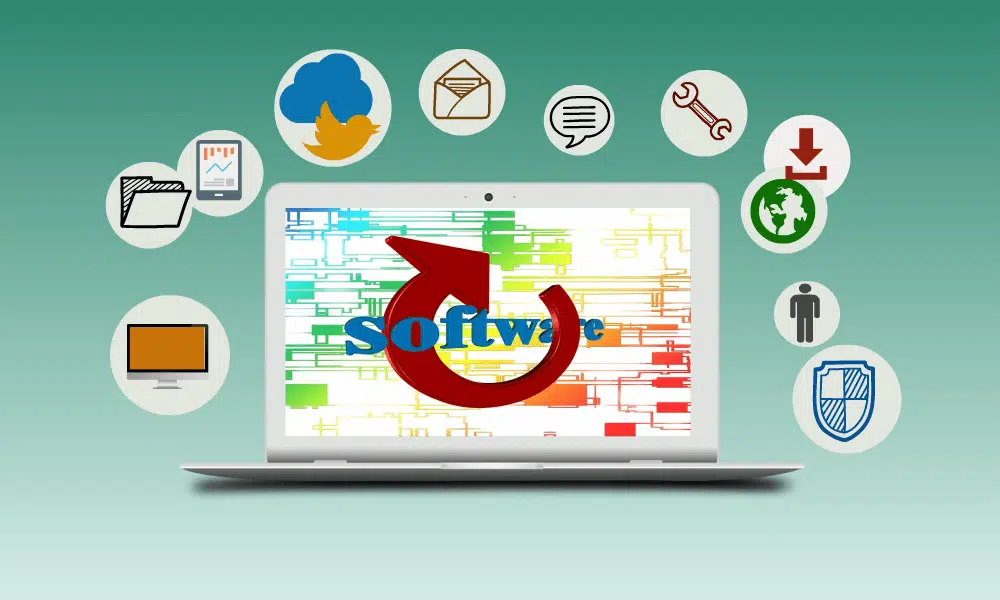
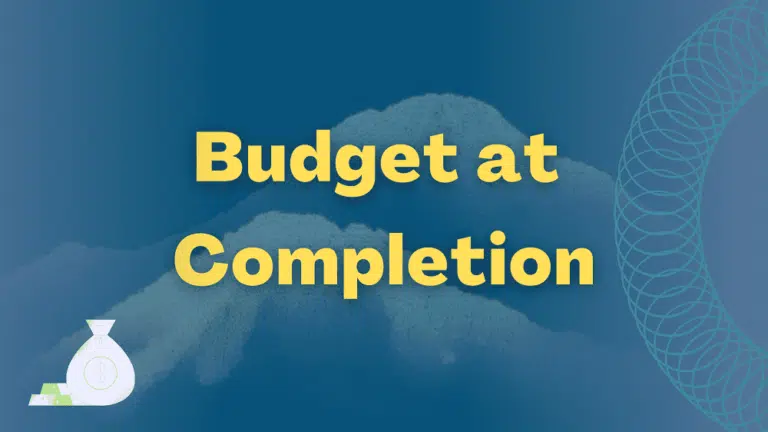
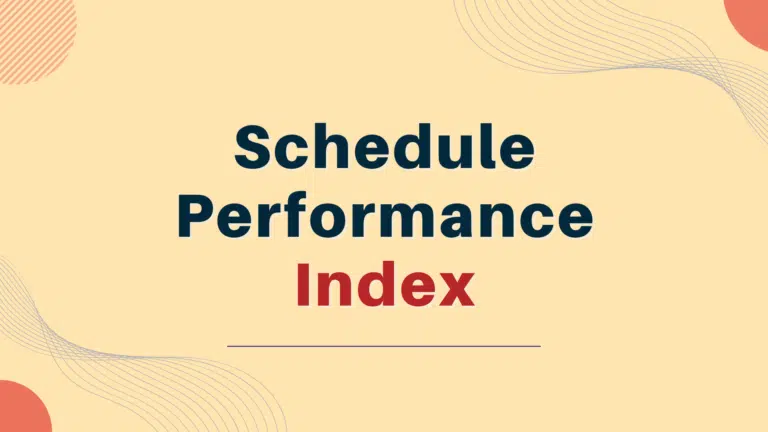




I just wanted to thank you for the knowledge. I was so confused reading about it and now that I am crystal clear with examples and theory . Wow ! Thx . Can you also write on ETC and EAC . This is another portion I need to get clarity before PMP exam .
Hello Shawn, you can find the other two articles here:
https://pmstudycircle.com/2012/05/estimate-at-completion-eac-a-project-forecasting-tool/
https://pmstudycircle.com/2012/05/estimate-to-complete-etc-an-another-project-forecasting-tool/
Sorry, But moving the goalposts may be a way of fooling yourself but it does not win the game. The formula TCPI = (BAC-EV) / (EAC-AC) using EAC = BAC / CPI will, by definition, provide the value CPI – i.e. carry on as before. Both algebra and your example prove this. In fact the formula in 1 TCPI = (BAC-EV) / (BAC-AC) for your example 2 gives 1.5. This indicates that if you can somehow improve your cost efficiency from now on to be 50% grater than the initial plan, you will finish on budget.
Now THAT is what you really need to know.
Well said Kik. Either improve the performance or move the goalpost.
Hi Fahad,
Excellent blog, well done and please carry on.
Through all the blogs, I have a problem with your example#2 which I do not believe is correct: your TCPI in example two should follow the standard formula based on BAC as your AC still below it (when we say under budget is comparing the actual to the planned – as we want to know if it is still possible to meet the budget and if yes with which future CPI, or actually CPI we need to increase our rate).
Thus, is you use standard TCPI formula (BAC-EV)/(BAC-AC)=(100k-40k)/(100k-60k)=1.5. This is the new CPI you must reach and if you do you will be spot on budget.
The other formula, is for over budget not based on current CPI but by having an AC superior already to the BAC, thus no way to make your budget anyway. So the idea is now to recalculate your new budget (EAC) and use it as new baseline to achieve. The upper part of the equation remains the same (BAC-EV) to express the remaining work (EV is a sub calculation of BAC by cumulating the completed work).
I believe that you need to change Example Case-2 with another one that shows the above over budget scenario.
In the second case we are Cleary over budget so we will use the formula based on EAC which is the new budget.
Hi Fahd, congratulations.
I come back to the example of TCPI using EAC = BAC/CPI. this suppose that you maintan your past performance cost.
Imagine now that this is not correct and that you have to maintain your 2 objectives : cost and deadline.EAC will be : AC+(BAC-EV)/(CPI*SPI)
In your example : BAC=100000USD/AC=60000USD/EV=40000USD
Suppose that PV=0.5*100000=50000USD(after half period of 6 months)
CPI=4/6=0.67/SPI=4/5=0.8
than EAC=60000+(100000-40000)/(0.67*0.8)=171940USD.
and finaly TCPI = (100000-40000)/(171940-60000)=60000/111940=0.54 which is coherent to respect deadline and budget and goes with the definition of TCPI.
TCPI in an overrun position without additional budget is a meaningless number. In evidence I offer your conclusion to the Overrun Calculation: “This means that you can continue with a Cost Performance Index of 0.67 to complete the project.” Continuing with Cum CPI of .67 only means the overrun is not getting worse. A TCPI of .67 is and indication of being able to run at 67% of future plan and meet budget. In this case with an overrun calculating a .67 TCPI is ridiculous, budget is gone.
Remember: • If the To Complete Performance Index is less than one, you are in a comfortable position.
I have never experience a comfortable overrun. Now I need my old pembok text to see what it says.
This is the definition of the TCPI.
Assalamualaikum Fahad,
What if the CPI = 1? which formula should we used?
I encountered below question, appreciate your advise.
Initial budget estimate of a project is 100.000USD. During execution of the project, Estimate at Completion (EAC) of the project has been found as 120.000USD. If earned value of the project is 20.000USD and CPI is 1.0, what is the TCPI of the project?
A) 0.8
B) 1.0
C) 1.2
D) 1.4
I answered it B = 1.0 since CPI =1, then EAC = BAC. I used TCPI under budget formula. But i got it wrong. The correct answer is A = 0.8, using TCPI over budget formula.
Thanks
If the CPI is 1, this means you are on track. Why would you calculate the TCPI?
AC = EV/CPI = 20.000/1 = 20.000
I guess since EAC is bigger than BAC (120.000 > 100.000) so the project is in over budget status. We should use:
TCPI = (BAC – EV)/(EAC – AC) = (100.000 – 20.000) / (120.000 – 20.000) = 0.8
So the answer is A: 0.8
You are confusing it with cost performance index.
TCPI is the future cost performance that you should achieve to complete the project within approved budget.
Helo Fahad,
Great blog, learning so much and your explanations are great and makes me understand the concept better.
I am confused with your statements below:
“If the To Complete Performance Index is less than one, you are in a comfortable position.” – If it is less than one it means you are over budget, then how can you be in a comfortable position. Please explain what I am missing.
“If the To Complete Performance Index is greater than one, you have to perform with a better cost performance than the past cost performance.” – If it is greater than one then you are under budget i.e. you have money left in hand. That is good right?
Can you please help me understand this better.
Hi Fahad,
Can you please tell me what if your tcpi comes 2.38. is it OK or the question is not correct. Because i think tcpi moves around 1 and do go beyond. kindly help.
Question is:
BAC=240000 divided equally over 12 months.
Today is 10th month
Project snapshot indicates that only 80% of Planned work could be Earned till today.
Actual Cost is 205000.
Now i am confused EV is 80% of PV or BAC. if i take 80% of PV then tcpi is more than 2 and if of BAC then its 1.34. KIndly help me out of it.
If I have CPI 1
If I have CPI < 1 and SPI 1 and SPI 1 and SPI >1
What TCPI formulas will be
if CPI <1 and not temporary we will use : EAC=BAC/CPI for future performance
if CPI <1 and Temporary we will use : EAC =AC+(BAC-EV) for future performance
if CPI < 1 and SPI <1 we will use EAC = AC+ (BAC-EV)/(CPI*SPI)
please correct me if I am wrong
please how can I relate TCPI formula with these conditions
Please read the blog post.
If you are over budget you will use the formula based on new budget (EAC) otherwise with the current budget (BAC)
You will to check the cause of this deviation. If it is temporary error and for the rest of the work can be performed as planned, you will not use this formula (BAC/CPI).
Anyway, after the new budget approved, EAC is the BAC.
hello Fahad,
as I understood, if I have CPI >1 we are under budget and we can use TCPI=BAC-EV/BAC-AC in this case TCPI < 1 so we are comfortable.
but if I have CPI 1 (example 1.5 ) so we are uncomfortable and we have to work with efficiency =150% to be within budget BAC.
in case we can not work with this 150% we will make new budget EAC=BAC/CPI and TCPI will be less than 1 which is equal to CPI but based on new estimate to be within EAC not BAC
PLEASE CORRECT ME IF I AM WRONG
You are right. TCPI is other way around of CPI
what if BAC=$1000000
pv-300000
AC-350000
% of work completed 25%
then what is
EV
CV
SV
CPI
SPI
EAC
TCPI
how to calculate all these
Read this blog post:
https://pmstudycircle.com/2012/05/fast-forward-earned-value-management-evm-forecasting-tcpi/
hey i have a question..
In a project control audit for a 5 billion dollars mega project, the observations at a particular instance indicate that project has been 80% complete and the corresponding “To Complete Performance Index” (TCPI) is 1.259. You are required to appraise the situation and briefly discuss your strategies from project management perspectives.
What i have to do??..
Fahad,
I have a difficulty understanding the interpretation of CV and CPI. Your first example exemplifies my confusion. I thought CPI tells you how much you get from each dollar spent or I should say what
And CV tells you whether or not you under budget or over budget. For instance if CV>0, it means you’re under spent. If CV<0 you're over spent. Am I correct?
You are right Mr Will.
CPI tells you how much you are earning on each dollar spent, and the cost variance greater than zero tells you that you are under budget.
https://pmstudycircle.com/2012/05/schedule-performance-index-spi-and-cost-performance-index-cpi/
https://pmstudycircle.com/2012/05/schedule-variance-sv-cost-variance-cv-in-project-cost-management/
Hi,
I have one doubt. If a project is over budgeted at a point of time and you are now required to calculate TCPI. Now, if you wish to calculate TCPI w.r.t. EAC then TCPI will always be equal to CPI that means there is no need to calculate TCPI w.r.t. EAC. A project will continue with same EAC budget.
Should not TCPI play a role when at a point of time you are over budget and now you wish to complete the project in the earlier approved budget i.e. BAC, then TCPI will be greater then 1(in all cases).
Your comments please.
You will always try to complete the project with BAC, and when it is not possible, you will calculate the new budget.
PMI did not come up with the concept of TCPI within the last few years. They didn’t come up with it at all. It has been around far longer than EVM has been called EVM.
Your example, while a good explanation of calculating TCPI, erroneously assumed that it is an acceptable practice to calculate that index against only the new EAC. It is a far more useful practice, and more diligent, to calculate it against both the new EAC and the BAC to ensure that there is clear visibility into the performance difference required to meet the terms of the contract versus the estimate provided by a program manager.
My example is based on the PMBOK Guide, which explains the two cases. Although I have given one example in this blog post, I have discussed the both cases.
I don’t consider it as an error.
Anyway I am going to update this blog post to include a mathematical example on other case as well.
Regarding the TCPI, can you please provide me any proof that it was being used before the PMI start using it.
Hi Fahad,
EAC used in above TCPI formula is BAC/CPI but everything is Not going normal.
So, i think EAC should be used as AC + (BAC-EV) / CPI *SPI –>> because we are over budget (60000) work done by 40000. In ideal case work had to be 50000 done.
Let me know what you think ?
There can be different situations to calculate the EAC. Once you get the EAC, you can use the TCPI formula.
Hello Hardeep,
Estimate At Completion, EAC = AC + ETC.
Estimate to Complete, ETC = pf x (BAC-EV) where pf is the performance factor.
pf = 1/CPI yields an Optimistic / Realistic results
pf = 1/(CPI x SPI) yields a Pessimstic / Realistic result
This is according to Oracle in Primavera P6.
You are right, since the project is behind schedule, the SPI should also be taken into account.
If TCPI is greater than 1 does it means we have to calculate one more time EAC or a new EAC ?
This means you are over budget and you may need to find a new EAC.
I remember TCPI as below :
Imagine you’re driving your car home and your wife has asked you to be at home by 7 pm. Its 6.45 pm now and still 30 miles to go. Your TCPI is the speed by which you’ll thrust your car to arrive home in time. :-)
Good example Kandarp.
Fahad, check xman’s response above (near the beginning). He explains it in detail. The main point is TCPI is to validate/determine what will it take to get back on track. One cannot assume that what looks like an estimate of 50% over budget will be met with open arms. One cannot expect to go get an increase in budget with what looks like extreme cost over runs. That is the main point. Thanks.
Yes, you are right.
I agree with xman. I believe the purpose of TCPI is to find out “What will it take to get back on track?”. It is not likely that being over budget by 50% will be welcomed. One should use TCPI to figure out how do I get control and get back on track. The PM should analyze why the project is off budget/schedule. Is the problem going to continue or was it just a one off (which EAC calc to use). Based on your example, I would say that the team has to work 50% harder/faster to get back on track (now it might not be possible or feasible) but that is what TCPI is telling me (1.5).
How did you come up with TCPI 1.5?
Because increasing budget (replacing BAC for EAC) means you are very easy on yourself. You can’t do it in a real world, most frequently.
So TCPI 1.5 comes out with leaving (BAC – EV)/(BAC – AC). Just this. And you do weekends for free.
If you increase the budget, your EAC will be your new BAC. No need to replace it with old BAC.
According to your explanation, EAC is the new approved budget. And it is only applicable if you are over budget (case-2).
Point 1:
In reality, the sponsor or client will not approve new budget if you have already over budget. Then have relax TCPI ratio (<1).
Maybe your case 1 & 2 is not intended for under and over budget but for old & new budget.
Just a thought.
First of all let me thank you for posting such beautiful articles. Earlier i was very confused after going through study material given by one of the training institutes and the trainer was also in hurry to complete the topic so he did not explained us very well. But after referring your articles all my doubts regarding the formulas and calculations are solved and i am feeling very confident for solving calculations. Thank you very much sir please keep on posting.
Thanks for your comment Vikrant.
Dear Fahad,
The above article on To Complete Performance Indicator(TCPI) was really good. Thanks for the detailed explanation on the same.
Can you please write similar article for To Complete Schedule Performance Indicator (TSPI), Final Cost & Final Planned Duration too.
All i got is ==>
1. TSPI = (Total Budgeted Cost – Earned Value (EV)) / (Total Budgeted Cost – Planned Value (PV))
2. Final Cost = BAC/CPI
3. Final Planned Duration = Estimated Hours/SPI
Thanks & Best Regards,
Vaibhav Wagh
Hello Vaibhav,
From where did you get this “To Complete Schedule Performance Indicator (TSPI)” term?
Hi Fahad,
Actually i searched for Earned Value Management(EVM) on google where i found many articles. I combined all terms of different different articles & i found that the term “TSPI-To Complete Schedule Performance Indicator” is not present in many articles(i think it is not there is PMBOK too). Also the article in which i found this term TSPI there they have “TCPI= To Complete COST Performance Indicator”.
As per them CPI indicates Cost Performance which is EV/AC & TCPI is ratio of (BAC-EV)/(BAC-AC) or (BAC-EV)/(EAC-AC) hence it is also relating with actual cost hence it is To Complete Cost Performance Indicator
&
SPI indicates Schedule Performance which is EV/PV & TCPI is ratio of (BAC-EV)/(BAC-PV) or (BAC-EV)/(EAC-PV) hence it is also relating with Planned Value hence it is To Complete Schedule Performance Indicator.
Now where did i get it (Just search TCPI & TSPI on google you will find it)
If you are under budget then there is no need to change the formula unless there is a huge margin which will indicate that there was some error in your cost calculations. If it is so, you can go for a new cost estimate…
what about the rest, and the definition, if I will not change the formula then I must spend more and earn less to match the BAC, and what for the over-Budget condition?
You will calculate parameters based on new approved budget.
OK, and I would calculate the new budget based on the EAC formula, which brings us back to the CPI=TCPI point every time I will use the suggested formula, so I mean the TCPI formulas it self is the problem, when I’m under budget I should use another formula for EAC such as “EAC=BAC-CV” which would mean reducing my budget by going back to the planned track and TCPI=1, or even reduce it using “EAC=BAC/CPI” which means TCPI=CPI and keep what you are doing by saving more money, and if we don’t calculate a new budget and we use the original BAC this means we have to spend more and waste what we have saved till now.
so it is all confusing in the under-budget situation only, what about over budget too.
TCPI gives you an indication how you’re performing. It helps you investigate further to find the future course of action.
I have two points, if I may ask:
from the definition of the TCPI it mean “how should I perform for the remaining work (BAC-EV) with the remaining planned Budget (BAC-AC)” – correct
from this, if I had bad performance before (original CPI 1, if not possible to perform like that then we request to change BAC to EAC, so in your example the original CPI<1 and using the definition the TCPI will be 1.5, if this correct then this make sense, but the problem if I use the same formula when I'm under budget then it will lead to TCPI < 1, which by your explanation is good and it is, but also mean you should spend more and earn less which is a problem, so I think we should make a new EAC and to be less than the original BAC by going back to track so that EAC=BAC-CV or EAC=BAC/CPI, because it means we can save more.
if we use the formula " TCPI=(BAC-EV)/(EAC-AC) " then the TCPI=CPI "original", always because the EAC=BAC/CPI, so why not to say TCPI=CPI.
sorry for talking "writing" so much
Hi Fahad,
Thanks for the great explanation.
please i need your support to explain “probability distribution PMPBOK 4TH page 297”
i am trying to understand what is the difference between discrete and continues distribution also what is uniform distribution ….. actually i cant understand anything from this page
thanks to support me to understand it
BR//
michael
Hi Fahad,
Thanks for the great explanation. I just have one doubt.
Let us take and example in which after going half way through the project progress we have the following figures
BAC=10000, EV=4000, PV=5000, AC=6000.
What should be the rate of work done so that the project completes in time and there is NO COST overrun. Practically project managers will be hit by this situation. They have to do the work mostly under tight budgets and getting approvals is very difficult.
Thanks in advance.
Regards, Avinesh
Read more: https://pmstudycircle.com/2012/05/to-complete-performance-index-tcpi-in-project-cost-management/#ixzz2SngDid6w
Follow us: @PMStudycircle on Twitter
Hello Avinesh,
Since there is no cost overrun, you can calculate the TCPI by using following formula:
TCPI = (BAC–EV)/(BAC–AC)
Which is TCPI = (10000 – 4000) / (10000 – 6000) = 6/4 = 1.5
Meaning you need to work a lot harder (150%) to keep up with the original budget.
Hi Fahad,
Thanks for the great explanation.
I just have one doubt. Let us take and example in which after going half way through the project progress we have BAC=10000, EV=4000, PV=5000, AC=6000. Can you please tell me what should be the rate of work done achieved by a project team so that there is no cost deviation. Thanks in advance.
Regards, Avinesh
Why do we have to put BAC in the numerator and EAC in the denominator in the case when we are over the budget? Would not it make sense to have EAC in both places if we want to compare “apples to apples”?
Both are representing the budget. EAC is nothing but a new approved budget.
Both are still apples!
:)
Can you explain the concept of Estimate At Completion (EAC) and why we have BAC/CPI formula?
Thank you
Hello Phillips, you can read about the Estimate At Completion (EAC) at:
https://pmstudycircle.com/2012/05/estimate-at-completion-eac-a-project-forecasting-tool/
I’m doing a practice test for PMP, and I’m having a difficult time understanding the formula used in the answer sheet.
——————————
The question:
For your project, find the to-complete performance index (TCPI) based on the given data:
BAC: 700,000
CV: 25,000
EV: 200,000
Estimate to Complete has now been revised to 425,000
——————————
My answer: Based on your explanation above, this project should be “under budget”, thus it is correct to use the formula of TCPI=(BAC-EV)/(BAC-AC)
But the answer sheet uses this formula instead: TCPI=(BAC-EV)/(EAC-AC)
Can you help me explain why?
Hello Chloe,
“Estimate to Complete has been revised to 425,000”, it means you budget has been changed.
Therefore, now you have to calculate the TCPI based on new approved budget, and that is “EAC”.
Remember one thing, if your initial budget (BAC) remains unchanged, then you can use the first formula otherwise go for the formula based on EAC.
In this example, the project manager realized his CPI was poor. He then convinced management to increase the project budget because of the poor CPI performance based on the original BAC. Now, he can continue with the poor CPI performance based on the original BAC since he got the increased budget. If we were to calculate the TCPI based on the new budget baseline, it would be 1, i.e. (EAC-AC)/ETC.
TCPI is an index that tells you which should be your future average CPI index of project performance regarding cost, based on actual CPI of the already project phased performed, if you wants to achive successfully the project total budget objetive.
Of course, if your actual CPI1 if you want to achive the same baseline BAC budgeting objetive, wich is the same to say that your average remaining EV has to be greater, than the remaining PV as first reference, and finally than the remaining costs you will use (expenditures) to perform the reamining project activities up to completion, to meat budget goal.
From this point of view the situation of “uncomfortability” is due that the cost performance within your project is unsatisfactory by now and you are oblied to take corrective and/or preventive actions to motivate the project team/staff/stakeholders in increasing majorly work productivity and/or effectiveness in on-going and from-now-on activities.
But, always from the PM(Project Manager) point of view, it is more unconfortable, to ask for the approval, from the executive Projects Director, of the ETC (BAC/CPI as Fahad Usmani calculation) budget like the new project total budget objetive.
Of course if you are able to conquest this without been head-cutted, your new TCPI should be <1 (and equal in value with actual CPI cause of ETC calculation formula choosed), and now the situation will be more "comfortable" (less uncomfortable would be righter) cause manteining, for example, your remainingEV=remainig baselinePV you have a margin to manage your project team/staff/stakeholders with minor productivity/effectiveness improvements.
I repeat the comment cause there was a misunderstanding sentence due to the difficulty in approaching TCPI concept. What I’m obviously trying is, departing from the intelligent Usmani’s exposition, readding yours smart comments/dubts and adding humbly my reasonings, to cause further discussions that allow all of us to better EVM knowledge by corroborating different points of view.
TCPI is an index that tells you which should be your future average CPI index of project performance regarding cost, based on actual CPI of the already project phases performed, if you wants to achive successfully the project total budget objetive.
Of course, if your actual CPI1 wich means that your future average CPI has to be >1 if you want to achive the same baseline BAC budgeting objetive, wich is the same to say that your average remaining EV has to be greater, than the remaining PV as first reference, and finally than the remaining costs (expenditures) you will use to perform the reamining project activities up to completion, to meat budget goal.
From this point of view the situation of “uncomfortability” is due that the cost performance within your project is unsatisfactory by now and you, as PM(Project Manager) are oblied to take corrective and/or preventive actions to motivate the project team/staff/stakeholders in increasing majorly work productivity and/or effectiveness in on-going and from-now-on activities.
But, always from the PM point of view, it is more unconfortable to ask for the approval, from the executive Projects Director, of the ETC (BAC/CPI selon Fahad Usmani calculation) budget as the new project total budget objetive.
Of course if you are able to conquest this without been head-cutted, your new TCPI should be <1 (and equal in value with actual CPI cause of ETC calculation formula choosed; personally I prefer ETC=[BAC-CV]/CPI formula to avoid this type of confusing coincidences), and now the situation will be more "comfortable" (less uncomfortable would be righter) cause manteining, for example, your remainingEV=remainig baselinePV you have a margin to manage your project team/staff/stakeholders with minor productivity/effectiveness improvements.
Read more: https://pmstudycircle.com/2012/05/to-complete-performance-index-tcpi-in-project-cost-management/#ixzz2Jg7Fb3OR
Follow us: @PMStudycircle on Twitter
Thank you Arturo for providing such detail explanation about the TCPI. In fact, TCPI is relatively new concept coined by PMI therefore many people find it bit confusing.
I think your this explanation will help them to better understand the topic.
Thank you so much Usmani for your comment; it’s great for me if you think I have done my bit to help.
Usmani, something happend when replaying comments that, again, certain phrases have lost words and they became confusing:
Example:
“Of course, if your actual CPI1 wich means that your future CPI has to be >1 if …”
it’s wrongly updated in web’s design regarding the action of someones reply; the correct phrase, as original writing and as you have read it firstly, is:
“Of course, if your actual CPI 1 by sure, wich means that your future CPI has to be >1 if …”
In any case I would like to express my thankfullness for your explanations. I’m approching by now your interesting blogs regarding Risk Management.
Hello Arturo,
I think that it might be a software bug. Hope by next update this issue will be addressed.
Thanks for your visit.
In the above example, even after we have increased our budget we are still not in a comfortable position with TCPI at 0.67…
I guess in this example it was a coincidence that CPI and TCPI are same and hence the confusion..
First of all thanks for the great article. Its very easy to understand. but i have a small doubt
you have said
If To-Complete Performance Index (TCPI) is less than one, then you’re in comfortable position.
Here in the above case we have a TCPI less than one (0.67) and we are forced to increase the budget from 1,00,000 to 1,49,253. It is not comfortable position as u have said.
Anyway thanks once again.
TCPI 0.67 is calculated based on new approved budget (EAC) i.e. $149,253. This TCPI is not calculated based on old budget (BAC).
I’m confused when i read your example too. Maybe you can add sth like
“This means that you can continue with a Cost Performance Index of 0.67 to complete the project. But he needs to get approval for EAC @149k”. Because the conclusion sounds like the project is ok but actually it’s bad.
You are right Josh since the CPI is less than one, you are over budget and you need to get approved new budget.